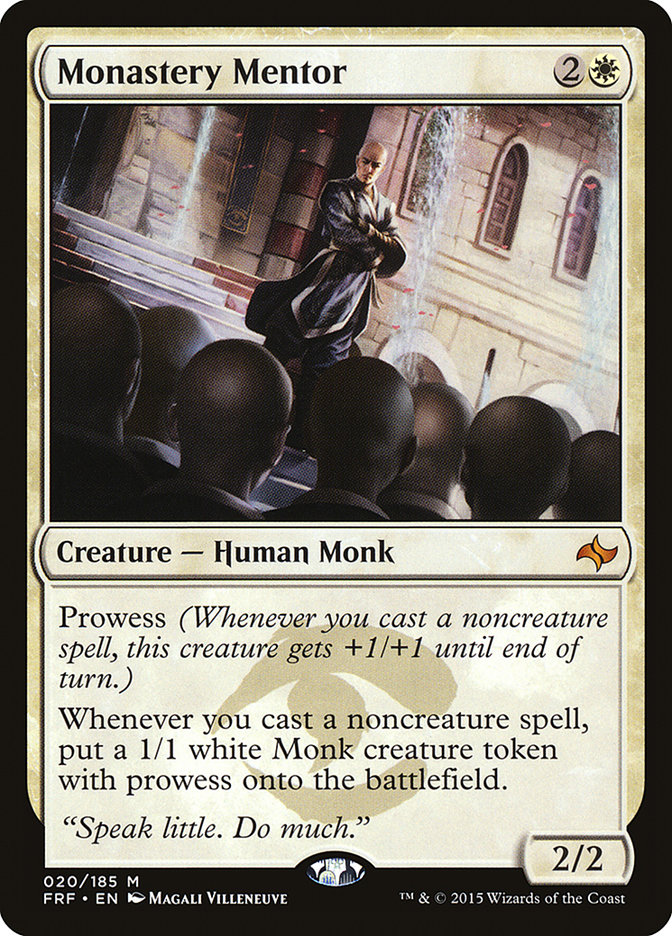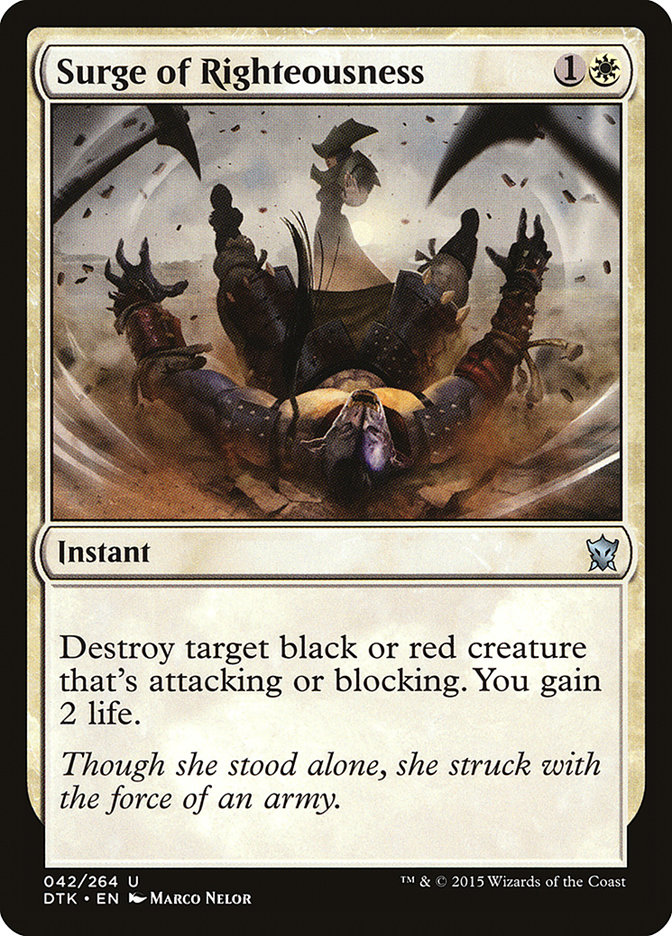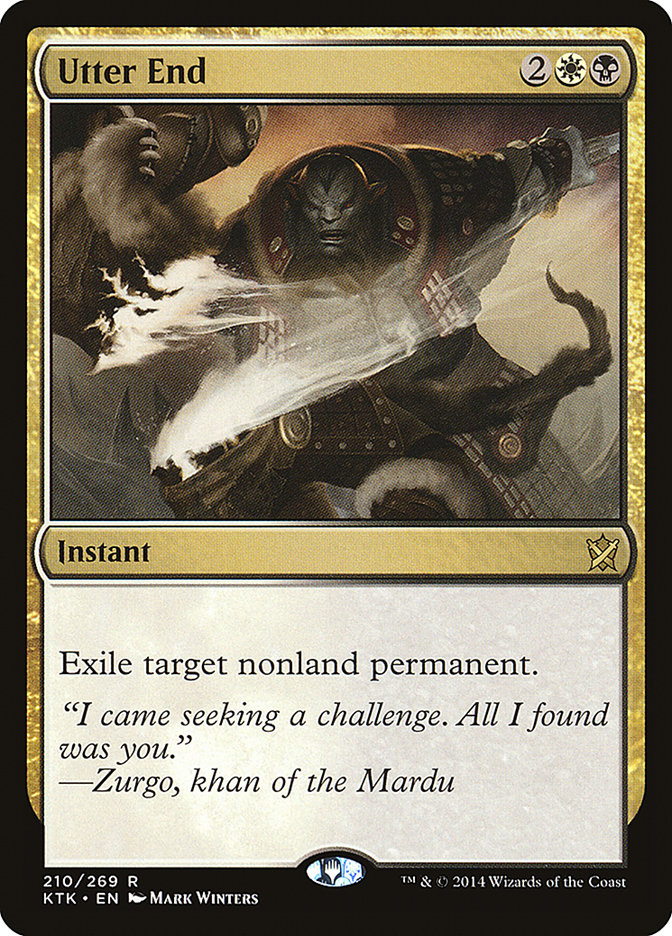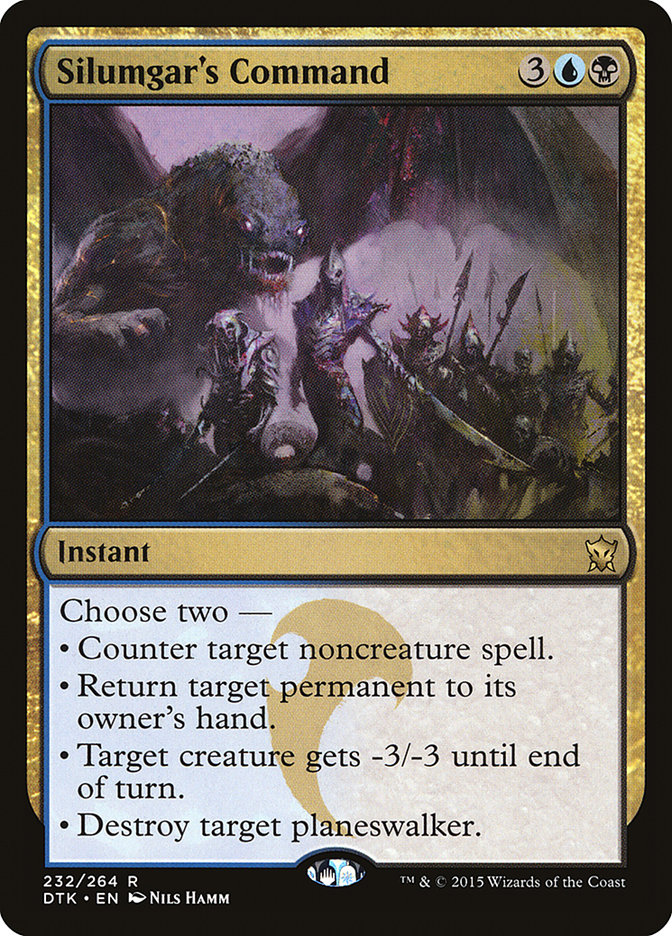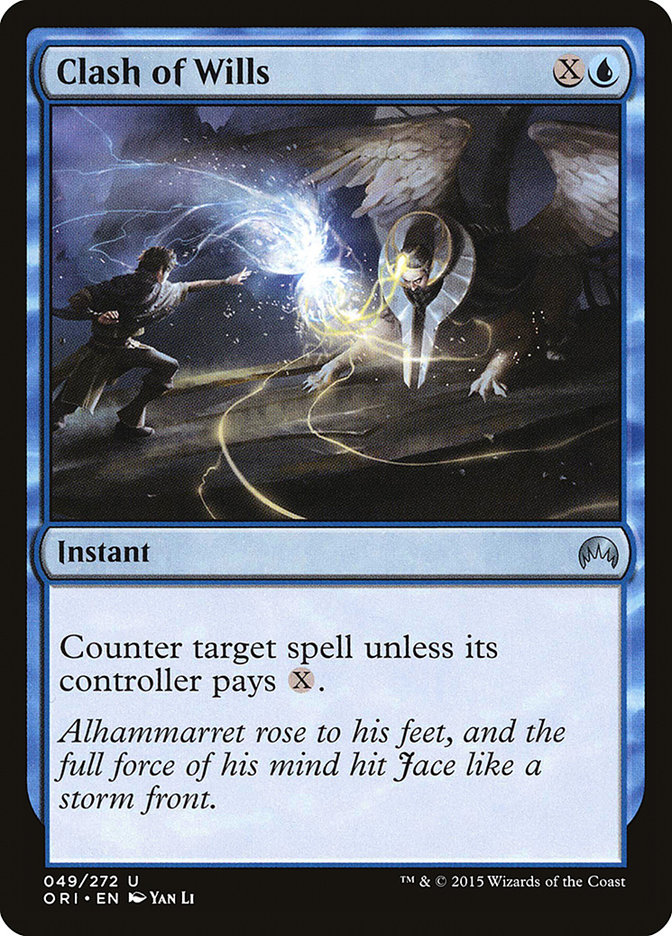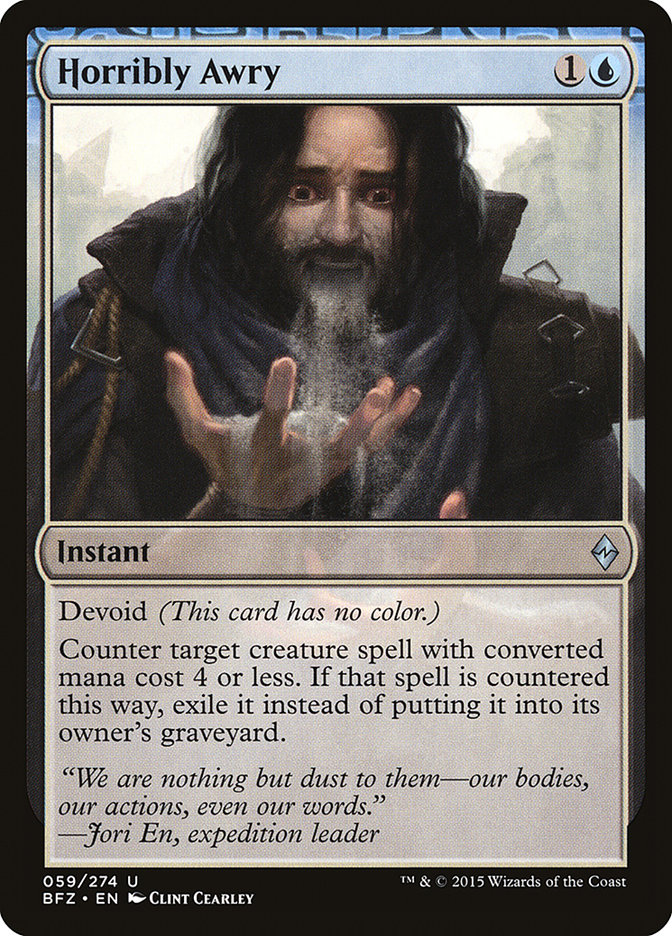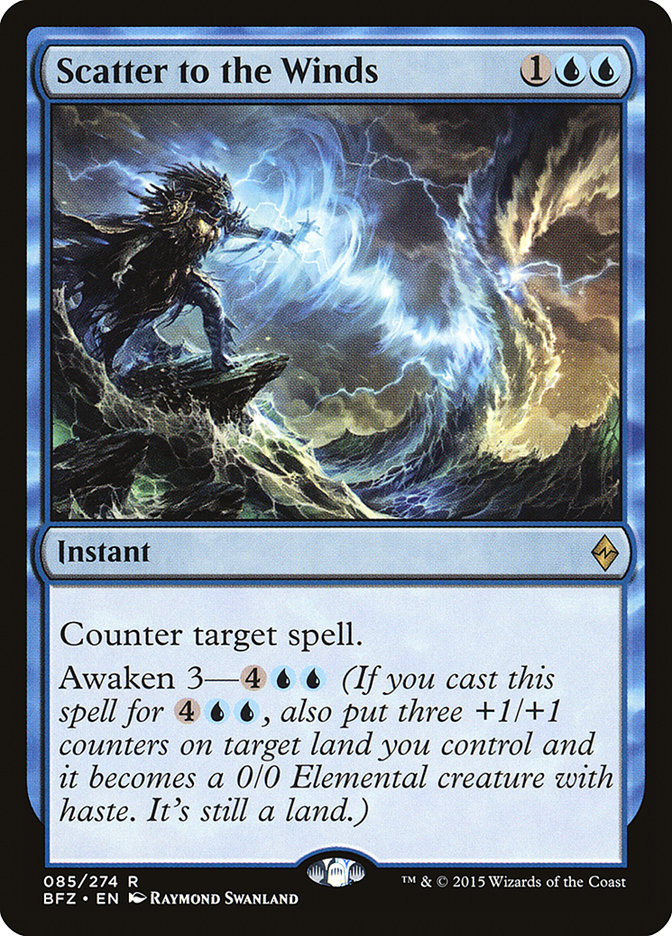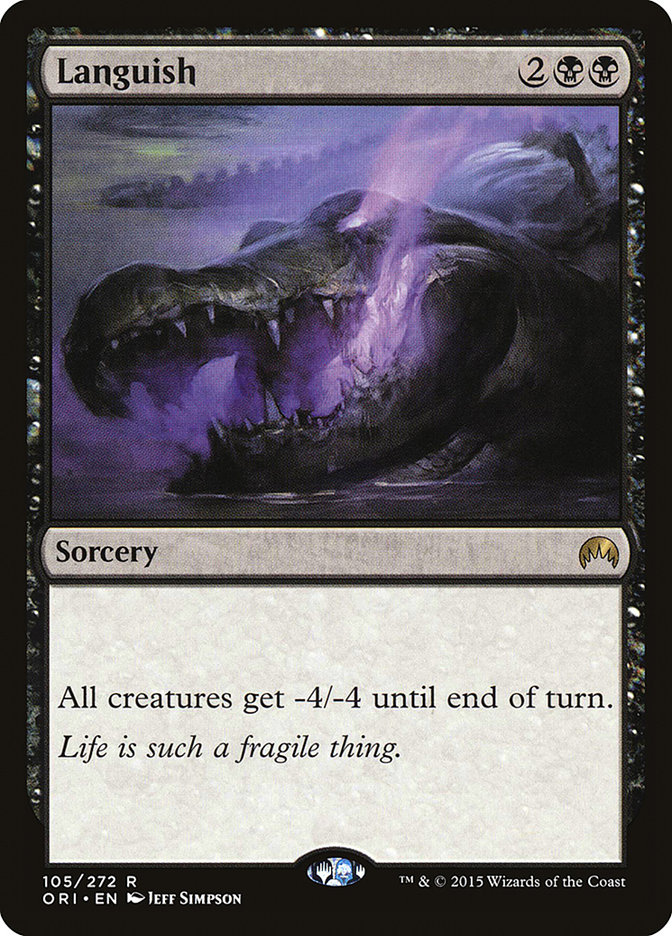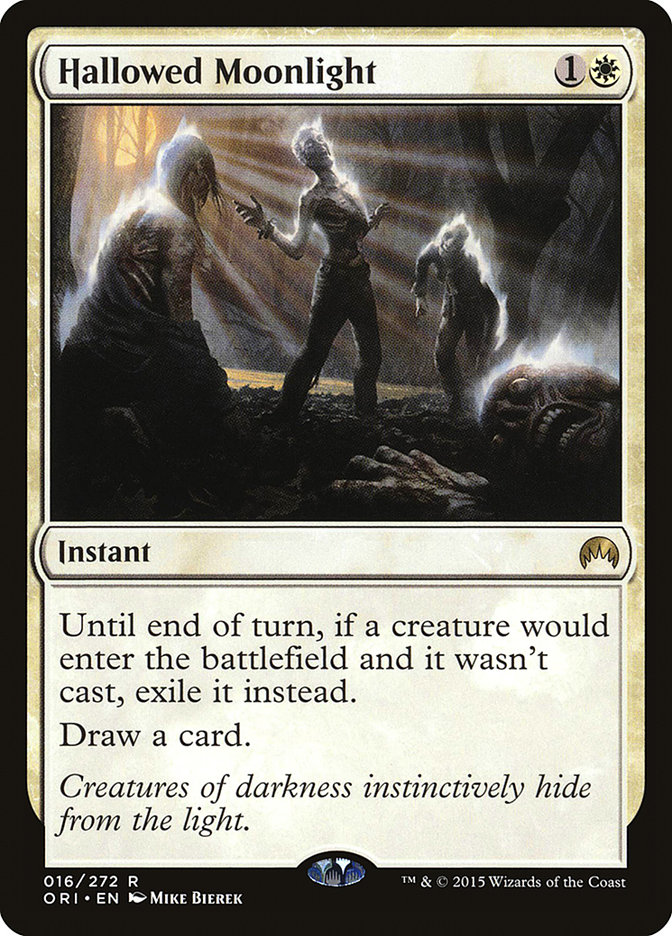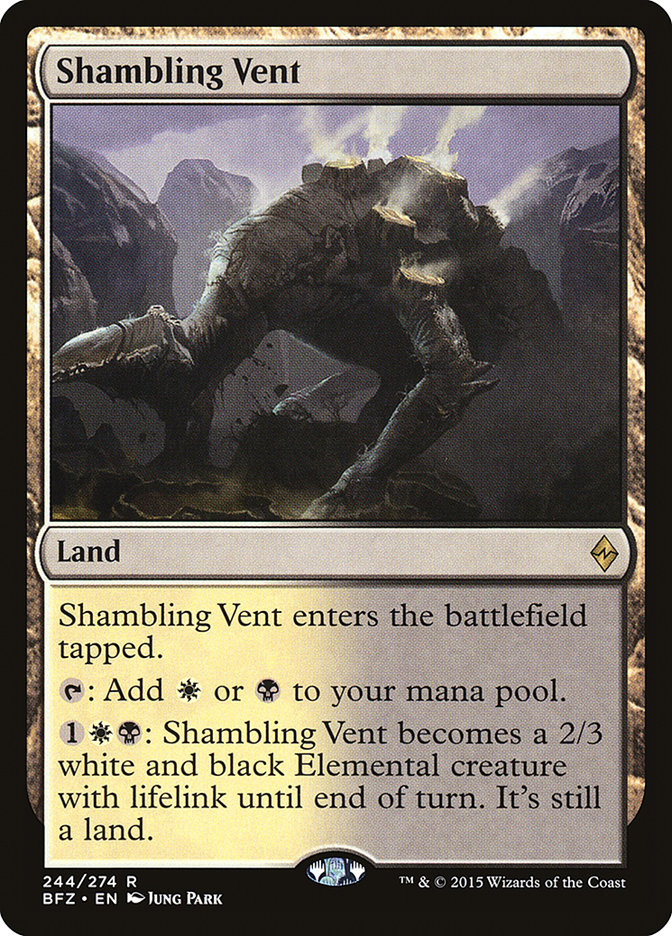Going into Grand Prix Indianapolis, I knew the biggest challenge facing Esper Control was avoiding draws. I think Paul Rietzl summed it up well.
“Esper Control is obviously the best if the rounds are untimed. But most of them aren’t, and I’m worried that it can’t beat the clock.”
Part of the context here, is that Jeskai Black and Abzan are over half of the field (which are both good matchups for Reid Duke-style Esper Control). If
the field shifts too much, things can change quite a bit. Baseline, The Pantheon Jeskai Black deck is the best if everyone is just playing whatever without
any metagaming considerations.
Jeskai Black has been one of the top two decks every single week of the format until now, so maybe people are finally tuning their decks enough to beat it.
This week, Jeskai Black was tied for most popular on day 2 (with Abzan); however, it crashed and burned. Despite being 22% of the day 2 field, it put zero
in the top 8 and just two in the top 16.
However, for this past weekend, I loved the positioning of Esper Control, but resolved to go to great lengths to avoid draws. Paul Rietzl, Matt Sperling,
and I are not the slowest players, and we ended up with five unintentional draws at the Pro Tour. My theory was that maybe we could make some changes that
might objectively lower our win percentage by a little, but reduce our draw percentage by a lot.
I employed a three-pronged approach to attacking this problem:
– Topping out with Ugin, the Spirit Dragon instead of Gideon and Ob Nixilis, backed up with more counterspells instead of Duresses. By moving toward a more
Reid Duke-style of Esper deck, we can actually take total control over a game and actually win in turns more often.
One of the problems with the Gideon/Ob Nixilis/Duress approach was sometimes your opponent could buy themselves seven or eight turns by just drawing a
removal spell. You would still win eventually, but it might take too long for the timed rounds. I actually went a step further than Reid, putting a
Dragonlord Silumgar in the maindeck and playing an extra Shambling Vent in order to actually close games faster.
– Playing fast starting turn 1. One of the risks is that playing this fast involves making lots of sub-optimal plays, but you don’t get as many draws (or
alternatively, you get to play a deck this strong that is normally balanced by the draws). Paul asked me at one point why I didn’t play an Ugin against an
opponent with five life and three cards in hand.
My answer was, “I am up 1-0 with ten minutes left, and if I just keep charging my Mage-Ring Network for a couple more turns and keep my shields up, I am
sure I will win.” Maybe the game is already won, but it would take a lot of mental energy to figure out that path, and I’ve already found a winning line.
The only credit you get for winning faster here is slightly more time between rounds. I’d rather take the higher confidence road to victory.
It’s very tiring to play the entire tournament in “hurry-up offense,” but I’ve gotten back into shape in the past several months and felt up to the
challenge. Even still, by the end of both days, I was getting tired and felt my play slipping. My day 1 ended 8-0-1 after a draw in the final round against
Esper Dragons, and there’s no question it was my worst played round of the tournament.
– Finally, I was committed to packing a lot of victory conditions in the sideboard. I wanted quantity, quality, variety, and I wanted some that could end
the game in a hurry. The plan was to sideboard in some victory conditions against everyone (whichever were best against them), but to have some options for
a lot more, so that whenever I was short on time I could overload the deck with threats, sort of transforming.
This final point was the area where the Team UltraPro build of Mage-Ring Esper makes its greatest advances. Paul accidentally broke it.
Unfortunately for Rietzl, he didn’t realize he broke it until about two rounds into the tournament (after not playing the deck). In the weeks leading up to
the event, Paul had been working on a variety of decks, including a U/W deck built around Monastery Mentor. After he explained the theory behind it, I
started to really fall in love with the card.
It started as a kill condition that could win in a hurry, and that could completely take over the game. Monastery Mentor had a lot of the same things going
for it that Ugin does in terms of going over the top and winning with just one or two attack phases. It’s common to play the Mentor with four mana open,
then Dig Through Time on their end step. On your turn, you Flashback Dig with Jace and now you have a ton of good cards in hand and will probably be able
to attack for 40 or 50 next turn.
When he started playing with it, he also noticed that he could actually win an occasional game or two against Eldrazi Ramp with Monastery Mentor (which is
usually a bad matchup for these control decks). They have a lot of trouble getting rid of it, and it has great chances of ending the game before they can
stick an Ugin if you have a little bit of permission.
The more I thought about Monastery Mentor, the more I loved it, but it was until I started drawing it in the tournament that I really came to appreciate
how amazing of a sideboard card it is for Mage-Ring Esper. Dig Through Time is obviously the best card in Esper, not close; however Monastery Mentor should
get the MVT award for Most Valuable Technology.
Throughout the weekend, a lot of people asked me:
When do you sideboard it in?
Games 2 and 3.
Jeskai Black is basically the only deck I don’t automatically sideboard it in against, and even there, I do if I am short on time (or just to mix it up
because you can’t let your sideboarding be too predictable in that matchup).
If you always sideboard Monastery Mentor in, why not maindeck it?
A lot of people have sooo much more creature kill maindeck. It’s not just Jeskai Black, with their Fiery Impulses, Wild Slashes, Kolaghan’s
Commands, and Crackling Dooms. Look at the Esper Tokens list Raymond Perez Jr piloted. It’s got four Silkwraps, three Murderous Cuts, two Utter Ends, a
Ruinous Path, and an Ultimate Price!
But if everyone knows you are going to sideboard in Monastery Mentor, won’t they just leave their creature kill in?
How are they making room for all those Duresses or Dispels or Negates or whatever other anti-control cards they plan on bringing in? It is nice when they
don’t know what your plan is, and it’s nice when you can bring in a variety of threats from different angles (like Dragonlord Ojutai’s durability and
Tasigur’s low cost with a card advantage component).
However, even if they do know, what are they going to do? Every removal spell they keep in their deck instead of another card they originally wanted to has
a very serious cost for them since they have to take something out. It’s not like Esper becomes all 2/2s for three. One of my favorite moves against Jeskai
Black players that knew I had Monastery Mentors was to sideboard out all of my Jaces(!) I don’t think I played against a single Jeskai Black player that
didn’t draw a post-sideboard Fiery Impulse and then just held on to it turn after turn without being able to make it do much of anything.
Here’s the list I registered for Grand Prix Indianapolis:
Creatures (5)
Planeswalkers (2)
Lands (27)
Spells (26)

There are a lot of styles of Esper Control at the moment, each with its own pros and cons:
● Mage-Ring Esper
● Esper Superfriends
● Esper Dragons
● Esper Tokens
There are elements of each that can be borrowed or blended, but it is important to remember the distinct elements and what they ask of you. If you are
playing Mage-Ring Esper, every four or five cost main phase card has a serious cost. If you are playing Super Friends, it’s hard to play very many
counterspells. If you are playing Dragons, it’s hard to play many planeswalkers. If you are playing Tokens, it’s important to make sure your removal can be
used offensively.
Reid’s Mage-Ring Esper looked awesome to me, and seemed a better path than the planeswalker build I played at the Pro Tour since it has a better Abzan
matchup in exchange for a worse red aggro matchup. I expected a lot of Abzan, while it seemed like red aggro was going to struggle with the rampant
popularity of Jeskai Black.
There were lots of differences in how I wanted to execute this style of Esper, compared to Reid, but without time to actually play any games, I relied on
two major shortcuts:
● Team UltraPro’s playtesting. Some of those guys play a ton of Magic and are able to offer invaluable perspectives and
experiences. Having a steady stream of new data, new experiences, as well as a sounding board goes a long way when you don’t have time to actually play
games yourself.
● Reid’s core list and thoughts on it. When I was nailing down my final list, I took Reid’s list and one-for-one lined up each card I had
different than him with the most logical card it was replacing. This way, I could gain greater confidence that I was not upsetting the delicate balance of
removal, permission, card draw, mana, etc.
This is textbook templating. It’s dangerous to rely entirely on theorycrafting, but by using Reid’s list as the template, I reduced the risk of some
fundamental design flaw slipping through the lack of playtesting.
I’d like to take a look at the individual card choices, particularly the ones that diverged from Reid’s list. For reference, here is the list I used as the
template:
Creatures (5)
Planeswalkers (2)
Lands (26)
Spells (26)

To begin with, I knew I wanted a maindeck Dragonlord Silumgar, which can take over games quickly and provide a powerful dimension to our ability to fight
planeswalkers. The drawback of most big creatures game 1 is that we end up vulnerable to Crackling Doom. Dragonlord Silumgar gets around this (assuming
they don’t have mana available when you cast it) by typically stealing Mantis Rider or Tasigur, so that we can sacrifice it to the Doom.
I don’t like Arashin Cleric maindeck because it just doesn’t swing the red aggro matchup enough to be worth how bad of a draw it is against most people.
It’s usually not terrible, but there are much more versatile cards to help in that matchup. Besides, you can spend tons of slots on fighting red
with this deck and still lose. Reid had seven dedicated anti-red cards and still failed to make day 2 despite never losing a game to anyone besides red
aggro.
I was fortunate to never face it; however, even if I had, I may be down an Arashin Cleric maindeck, but I did get to upgrade a Murderous Cut to a Surge of
Righteousness, and an Ojutai’s Command to a Languish. Additionally, my mix of permission is better against red, I have an extra Shambling Vent, and I even
have a Hallowed Moonlight instead of an Anticipate (to use against Dragon Fodder and Hordeling Outburst). After sideboarding, I may have two less Clerics,
but I have Monastery Mentors instead, not to mention an extra Duress and a Tasigur to block with.
I’m certainly not suggesting this build beats red. I just think Arashin Cleric isn’t slot efficient, and it isn’t worth trying to beat red that way. I used
two slots on Clerics I never used, as it was. It reminds me of fighting Lava Spike decks in Modern with Grixis. You can use Dragon’s Claw, but it’s so much
more slot efficient to just have a ton of Dispels, Countersqualls, Flashfreezes, Spell Snares, Inquisition of Kozileks, and so on. In a lot of red aggro
matchups, the individual good cards aren’t as important as having as few bad cards as possible.
Compared to Reid’s list, I have replaced a Murderous Cut with a Surge of Righteousness, which seems to surprise a lot of people, but who doesn’t have
targets? Yes, yes, G/W Megamorph, of course, but even a totally dead card isn’t that bad since Jace can loot it away. Meanwhile, it gives us some much
needed lifegain to help make up for the missing Arashin Cleric and Ojutai’s Command. It’s also just a very efficient way to deal with Mantis Rider and
Siege Rhino. The main weakness is its inability to kill Jace, Vryn’s Prodigy, though it can also be annoying when they know not to attack with their
Tasigur and just sit there drawing cards.
A lot of people seemed down on Ultimate Price this week, but I’m not sure why. It’s awesome against Jeskai, killing Jace, Tasigur, Soulfire Grand Master,
and Dragonmaster Outcast. It’s good against Abzan, killing Warden of the First Tree (which, along with Gideon, is one of the only two ways I ever lose to
Abzan with control now). It’s one of the best cards against Mono-Red (where being an instant is huge). It eventually kills a Jace against control. Its main
weakness is against token decks, but even they usually have Knight of the White Orchid or Wingmate Roc, which is at least something.
Yes, these are expensive ways to interact, but they are excellent. The versatility of Utter End is just so big right now. There are enchantments,
indestructible threats, Hangarback Walkers, planeswalkers, haste creatures, and more. Having some catch-all answers is really important at the moment.
Silumgar’s Command isn’t as good as Utter End, but I like one better than the third copy. It still usually kills the creature or planeswalker like we need,
and it can bounce the enchantment or whatever, but it’s also a back-up counterspell, and you do get two-for-ones sometimes. The most common of these is
kill your Warden of the First Tree and Gideon, or Mantis Rider and Jace. It’s also not the worst way to catch up against an opponent that snuck an end step
Ojutai’s Command on their Dragonmaster Outcast, when you were tapped out. You can give the Outcast -3/-3 and bounce the token, evening the playing field.
While Reid’s build is all-in on Clash of Wills, I find Clash of Wills unacceptably mediocre on the draw to play that many when there are good alternatives.
A lot of people underestimate how often they should be sideboarding differently on the play versus the draw. Besides, when you have a bigger mix of
permission, it’s harder for people to play around it.
Horribly Awry has several really nice things going for it. To begin with, it’s reliable. When an Abzan player Duresses you, it can sometimes be hard to
make Clash of Wills work right. They are good against Clash of Wills anyway, since Warden of the First Tree and Den Protector require only part of the mana
up front. Horribly Awry, on the other hand, even exiles and is a very mana efficient way to keep them off of a Siege Rhino or Den Protector. It’s also a
great counterspell to follow up a Languish or Planar Outburst with.
Against Jeskai Black, I like Clash of Wills on the play, but it really drops in value on the draw. They already have Duress, Dispel, Negate, and Disdainful
Stroke, not to mention Tasigur usually coming down for one mana. If you don’t have the ability to stop their two-drop (by being on the play), Clash is only
so-so.
Horribly Awry, on the other hand, is particularly nice for combating their Ojutai’s Commands. They really don’t have that many Jaces and Dragonmaster
Outcasts, and they usually board out Soulfire Grand Master. Often, they will drop a Dragonmaster Outcast on turn 6 with five mana open. This makes it
nearly impossible to Clash, and even if you kill it, they can threaten to get it back with the Command. Horribly Awry, on the other hand, is perfect for
this spot since it exiles the Outcast and works no matter how much mana they have.
While Horribly Awry is great, I’m glad I only played one since it can’t counter traditional planeswalkers. Paul’s U/W list featured more Horribly Awry,
Negate, and Scatter action, with zero Clash, while Reid’s list maxed on Clash. What was I supposed to do? I don’t like it when Mommy and Daddy fight!
I decided to split the difference and play two Clash, minimizing how wrong I could be in either direction. While one Clash had become a Horribly Awry, I
knew I wanted the other to be Negate. Negate is just so good right now, and in fact, I believe Reid actually ended up cutting Scatter to make room for a
second one, himself.
Looking back, I was happy with the amount of cheap permission (six, just like Reid’s list); but moving forward, I think I want to try a Dispel or a third
Negate, instead of the second Clash. Dispel would be a slam dunk, except that W/B with Gideon, Ob Nixilis, and Sorin is on the way up, so I could see it
either way.
I knew I only wanted to play three Ojutai’s Commands, but Languish was actually the last card to be added to my deck. Ojutai’s Command is awesome,
particularly in this deck; however, the format has adjusted to just how popular the card is.
I had originally had a Tasigur in this spot, but I decided that I was already pushing the delve mechanic pretty hard. I decided it should be a removal
spell after looking at the sort of lists Paul was liking, and considered Silkwrap, Stasis Snare, Ruinous Path, Foul-Tongue Invocation, and Complete
Disregard.
Silkwrap is still awesome, but the sorcery speed aspect is a real thing, and of course, it’s a nonbo with Ugin. Stasis Snare is more of what we want, and
kind of perfect except for the Ugin issue. You do Ugin -2 enough that maybe we could live with it. However, there are enough other good options, why adopt
the weakness?
Foul-Tongue Invocation provides some lifegain once in a while and would be particularly nice after sideboard, but I felt like there would be too many
Hangarback Walkers for this to be a serious option. Complete Disregard is especially nice against Hangarback Walker and was my leading candidate; however,
Languish ended up offering a more appealing avenue of attack against the increase in popularity of token-based strategies I was expecting.
Ruinous Path was a serious candidate despite the sorcery speed since killing planeswalkers is so important. However, getting double black on turn 3 is
actually much harder than it looks since we don’t always want to have to fetch up basic Swamp. Without basic Swamp, there aren’t any combinations of our
land that let us play a two-cost spell on turn 2 and then Ruinous Path on turn 3.
If a double black sorcery for three is too hard, why are we okay with a double black sorcery for four? Well, getting the second black on turn 4 is actually
much easier. If we played a Shambling Vent or Sunken Hollow on turn 1, we can actually play or fetch whatever basics we want and still be able to fetch up
an untapped Sunken Hollow on turn 4. Languish is still the “hardest” to cast spell in the deck, but it’s nice to be able to take advantage of opponents
that think you can’t sweep the board until turn 5. Owen Turtenwald made some good points about Languish being underrated again, and I thought it would fit
in nicely with my Dragonlord Silumgars and Tasigur, the Golden Fang out of the sideboard. It’s also a nice way to get some percentage against red aggro.
Speaking of anti-token cards, I decided to turn one Anticipate into Hallowed Moonlight, as a surprise trump card that could always at least be cycled. It
cantrip counters half of an Ojutai’s Command, which is nice. It gives us more Hangarback Walker protection. It’s a monster against Goblin tokens. It
reduces the effectiveness of Wingmate Roc. It’s a super incredible foil to Rally the Ancestors and Collected Company.
That said, it was kind of worse than Anticipate for me.
Don’t get me wrong, it wasn’t bad. I did hit a Roc token, a Gideon Knight Ally, a Sorin Vampire, some Hangarback Thopters, an Ojutai’s Commanded
Jace, a Nissa’s 4/4 Elemental legend, and some Retreat to Emeria Kor; but most of the time, it was just an Anticipate with my eyes closed that was harder
to cast.
Now, I never faced red aggro or Rally, and W/B Tokens is going to continue to rise, so I am kind of wanting to give it another chance. It was fine, and
maybe would have been great with slightly different pairings. I’m not sure. I do know there’s some serious “Shadow of Doubt” equity with Hallowed
Moonlight, though. It’s the type of card that tilts people to have been “gotten” by, and people weirdly try way too hard to play around it.
An important tactical point to remember is that when you have a Monastery Mentor, you can cast Hallowed Moonlight and get a token before the Moonlight
resolves. Another important tactical point is that Hallowed Moonlight does not stop Jace or Nissa from coming back when they flip. A lot of people
are confused about this because it works wrong on Magic Online. Of course, they might also be confused about the nature of the Magic Online experience.
I’d just like to take a moment and remind people not to sideboard out Dig Through Time when they play Esper. Ever. No, not against Mono-Red, not against
Four Dispels: The Deck, not against anyone. It’s banned and restricted in every other format, and it’s definitely too good here. The only reason it’s
tolerated in Standard is because it’s rotating out soon anyway.
Shambling Vent is a really strong Magic card and a very misunderstood one. I wanted very much to play the full four; however, there is some risk to drawing
multiple non-blue lands. I knew I wanted two Mage-Ring Networks, but the Haven of the Spirit Dragon versus Shambling Vent decision was a close one.
To make room for the Shambling Vent, I cut an Island, since I just felt like Reid had too much blue mana and not enough white mana in the first place,
presumably an artifact from early builds that were heavily reliant on Scatter to the Winds. Once I was adding a Languish, I liked the idea of adding a
black as well (Reid had no double black cards in his list).
Because of my maindeck Dragonlord Silumgar, Surge of Righteousness, and Negate number two, I had three extra slots to start with, which I dedicated
completely to additional victory conditions to help minimize the risk of draws, as detailed earlier.
While I did play a copy of Infinite Obliteration as a trump against Eldrazi Ramp, I am not sure it wouldn’t be better as a third Monastery Mentor.
Certainly the more Mentors you play, the easier it is for people to sideboard against them, but I can’t stress how incredible the card was for me,
particularly against Abzan, which has to bend over backwards to try to Abzan Charm it (and which should probably just suck it up and play some Murderous
Cuts and Ultimate Prices against us).
Even though I was down an Arashin Cleric maindeck, I decided to trim an Arashin Cleric from the sideboard for a Duress. Duress isn’t as good against red as
the Cleric, but it is quite good. Having the extra Duress gives us very real percentage against Jeskai, Tokens, Eldrazi Ramp, and the mirror.
Finally, I didn’t feel like the Foul-Tongue Invocation was pulling enough weight. I was thinking of replacing it with another removal spell, but I wanted
to make room for another card draw spell. As detailed last week,
I prefer Painful Truths to Dragonlord’s Prerogative these days. Its low cost means we can use it to recover against opponents sideboarding in discard
spells much earlier, and needing to spend only three mana makes it a much better turn 5 or 6 play, where we can also follow it up with a removal spell or a
counterspell.
I ended up top 8ing Grand Prix Indianapolis with a record of 12-1-2 (the second draw being intentional, in the final round), before falling to Raymond
Perez Jr’s Esper Tokens deck. My records versus different decks:
Jeskai Black 4-0
Abzan 3-0
Esper Control 1-0-1
Bant Tokens 1-0
Hardened Scales 0-1
Esper Tokens 0-1
Andrew Cuneo’s Esper Control was an interesting new take on the archetype that seemed well worth taking a look at. For Esper aficionados:
Planeswalkers (4)
Lands (26)
Spells (30)

Andrew’s list had a lot of similarities to mine, except with Narset and Ob Nixilis instead of Jaces, and then a white enchantment control package, rather
than removal and Ugins. He said he was pretty happy with his maindeck, but that the sideboard needed work. I would add a couple Duresses and a couple of
Monastery Mentors to the sideboard to see how far that goes. I certainly don’t love the playset of Arashin Clerics, and the Felidar Sovereign is probably
just a bad Monastery Mentor.
I enjoy the Pearl Lake Ancient and considered playing one in my sideboard, but I think that’s the wrong way to fight those matchups right now. What you
want is a ton of Dispels, Negates, and Duresses, along with card draw. Mage-Ring Network is also just king in the mirror. If Esper ever gained popularity,
I wouldn’t want to play Esper Control without them, and in fact, would want a third if possible.
If you like control decks, this one is a good one. If you’re considering playing it in an event featuring timed rounds, I would recommend doing your
playtesting in hurry-up mode to get a better feel for what it’s like. It’s not the hardest deck in the world to pilot, but it is quite challenging piloting
it fast enough.
This format’s been fun, but now I’m turning my sights to a different kind of Jace format…
The rumors of Legacy’s demise has been greatly exaggerated.
…
Its tournament scene is going to evolve, but too many people enjoy the format too much to let it die.


